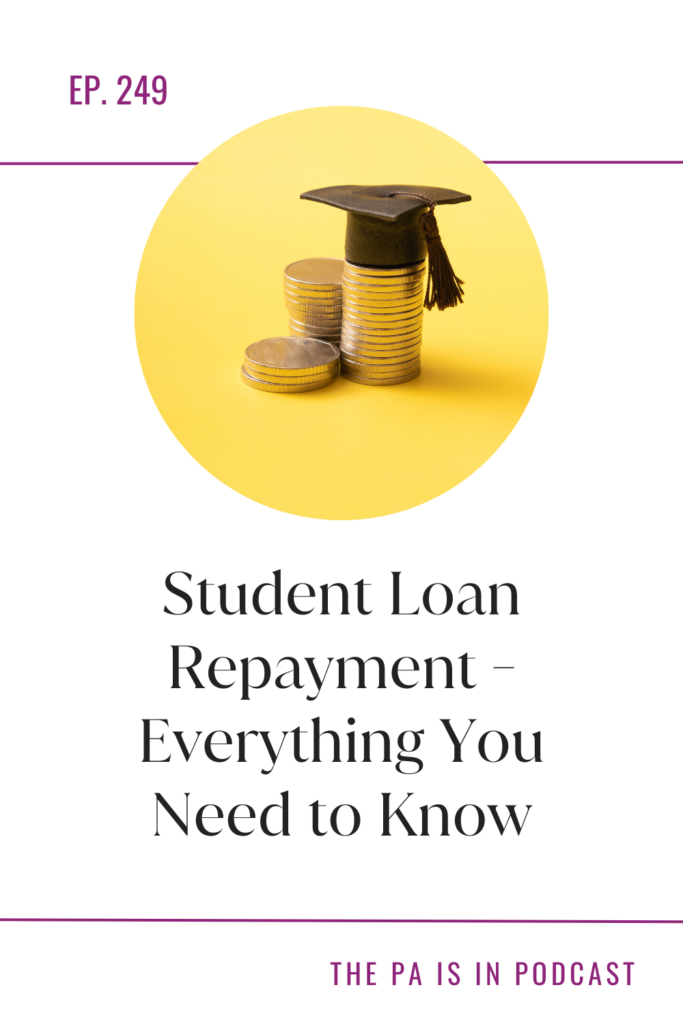
Today on the podcast I get to welcome back PA Kristin Burton to share her financial expertise on all things student loans. Kristin is the founder of Strive Coaching, where she teaches medical professionals how to achieve financial independence and money literacy.
Kristin and I take a deep dive into the various options that exist on repaying student loans, including what to consider in the short term and the long term. We discuss the best methods for repayment as well as how to prioritize paying off your student loans with your other money goals, like retirement, travel, and kids’ college savings.
Listen in to learn what you need to think about when choosing a student loan repayment option as well as to hear some actionable tips on how to set and achieve your own financial goals.
Listen to the Podcast: Apple Podcasts | Spotify
Watch on YouTube
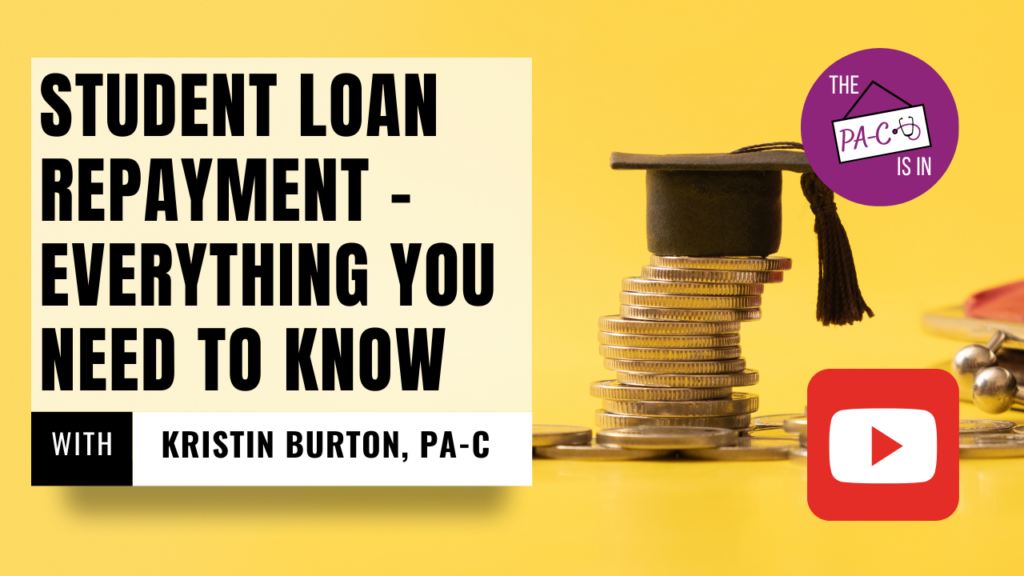
Meet Kristin
Kristin Burton is a Critical Care PA and the founder of Strive Coaching, where she educates other medical professionals on all things personal finance. She paid off $161,000 in student loan debt in 16 months and then became a millionaire at 31 years old through stock market and real estate investing.
The SAVE Plan
The SAVE (Saving on a Valuable Education) repayment plan is used by many medical professionals, but is also the cause of big student loan mistakes. Most people don’t have a long term financial picture of their loans. Instead, people pick a payment plan based on the lowest monthly payment or what a colleague is doing. This is not the best way to choose which repayment method is best for you.
The government determines your discretionary income using a percentage of the federal poverty limit based on your family size. They then translate that into what your student loan payment will be.
SAVE is usually the lowest or one of the lowest monthly payments of any of the payment plan options. SAVE uses 225% of the federal poverty level. Other income-driven repayment plans use 100% or 150%. SAVE also uses a 5% metric for discretionary income for undergraduate loans and 10% for graduate loans. The biggest perk of SAVE is interest subsidy. If your payment is less than the interest it would have accrued, the remaining interest is waived.
Student Loan Repayment Options
When choosing which student loan repayment you want to use, you first need to step back and look at the big picture.
There are 3 broad strategies you can choose when determining how to pay off your student loans.
1a. Traditional payoff – Pay off your loan over the course of 10 years
1b. Accelerated payoff – Pay off your loan faster than 10 years
2. Public Student Loan Forgiveness (PSLF)
3. Taxable Loan Forgiveness
If you utilize either PSLF or taxable loan forgiveness, you need to choose an income-based repayment plan; most people choose SAVE. You will pay a smaller amount per month than if you chose the traditional 10 year track payoff or accelerated payoff strategies.
However, if you pay less per month, then you’re increasing the duration of time you’re paying on your loans. You’re also increasing the total amount of money you’re paying as a result.
For PSLF, at the 10-year mark, any remaining loan is forgiven on a tax-free basis. For taxable loan forgiveness, your remaining balance at 20-25 years is also forgiven. There is no need for a qualifying employer or to meet specific criteria, but the balance is taxed when it’s forgiven. You need to therefore plan for the “tax bomb.”
Tax Bomb
Think about your debt to income ratio when planning for your eventual tax bomb. A low debt to income ratio (less than 1) means that the total you owe is less than your annual income. If you chose SAVE, you likely won’t have any remaining balance at all at the 20-25 year mark. There will be nothing to be forgiven because you already paid it all off. Therefore, there is also no tax bomb.
A high debt to income ratio (3:1 or 4:1) means that you owe 3x or 4x what you make annually. In this case, you probably will have a balance remaining at 20-25 years. Therefore, you will have a big tax bill to pay when the rest of the loan is forgiven. You could have hundreds of thousands of dollars forgiven depending on your total student loans, so your tax bill could be 10s of thousands or 100s of thousands of dollars.
When choosing which route to take to pay off your student loans, you need to plan far in advance. You need to plan for the tax bomb if you know it will be coming in 20+ years. When choosing your payoff strategy, you need to think about not only how the monthly payment affects your budget and lifestyle today, but also your money goals and lifestyle 5, 10 and 15 years down the road. Many people want immediate gratification, but we need to think through long term implications of our decisions.
Feeling Buried Under Student Loans
Insurmountable student loan debt feels like your biggest money problem, but it’s actually not. You can still be tremendously financially successful and still have a large student loan burden. Don’t let this create a limiting belief that you’re bad at money.
Get out of the overwhelm by making the first decision on how to clear your debt. Choose the traditional or accelerated payoff strategy, PSLF, or taxable loan forgiveness. Making this decision is your first step to getting out of debt.
Social science studies have shown that the amount of debt doesn’t correlate to stress and depression. The feeling of being able to manage your debt matters more. By having a plan and knowing that you’re managing your debt, you can lower your stress and anxiety surrounding your student loans.
Debt Snowball versus Debt Avalanche
The debt avalanche method involves ordering your debt in order of highest to lowest interest rate. You pay the debt with the highest interest rate first and then go down in order to the debt with the lowest interest rate. This is the best strategy mathematically because you will pay less money overall.
The debt snowball method involves ordering your debt from lowest to highest amount. You pay the debt with the lowest overall balance first and then continue in order to the highest payoff balance. This method provides early big wins psychologically, but you will pay slightly more money overall.
Kristin recommends that debt should always be paid in order of interest rate utilizing the avalanche method because it is best mathematically. If you have all federal loans, your interest rate spread is probably narrow, but if you have private loans, you’ll have a wider spread of interest rates.
The snowball method can be better from a psychological standpoint, but you can create your own psychological wins by creating your own rewards system while using the avalanche method.
Debt Payoff Resources
What resources exist to determine how different payment strategies such as paying more or faster will affect your payment timeline and overall amount paid?
You can create an Excel spreadsheet and an amortization schedule to manually calculate your options and results.
Kristin recommends an online calculator at www.unbury.me. You can input all your debt with interest rates and minimum payments and select whether you’re utilizing the avalanche or snowball method. The calculator has a slider you can use to change your payment every month, such as choosing to pay an extra $500 per month. You can then see how it changes your total interest paid and your time to debt freedom.
You Need a Written Plan
Kristin explains how everyone needs a written plan for how you’ll pay off your debt. It’s imperative to use calculations with specific numbers. From there, you can make decisions on how to best reach your financial goals.
Do I pay extra to student loan debt and if so, how much? If you plan to pay off your debt in less than 2-3 years, then it makes sense to put all your extra income to your student loan debt.
However, if you choose to pay only $500/month or so, it will decrease your timeline to 6-7 years. In this scenario, you shouldn’t make paying off debt your only goal. You also need to focus on retirement. If you don’t invest for retirement in those 6-7 years, you’ll be behind. You’ll need to invest almost as much as you were paying to your student loans to catch up.
You need to have a plan and a sense of urgency for retirement investing, especially since most medical professionals don’t graduate and start working until their mid-late twenties (or later).
How to Prioritize Money Goals
There can be several competing money goals people grapple with – student loans, other debt, retirement, kids’ college, travel, etc. How can we prioritize which goals to focus on?
Kristin recommends this strategy:
1. Invest 20% of your gross income to retirement accounts. This should create an inflation-adjusted standard retirement (mid-60s)
2. Pay off high interest debt
3. Decide on a student loan strategy. Have an intentional plan written on paper.
4. Decide on your other goals, such as early retirement, saving for your kids’ college, and travel. These are very personal and based on your own goals.
Funding your own retirement needs to come first. After that, it’s mostly personal choices with no right or wrong. This is the art, not science, of investing and personal finance.
Kristin suggests people utilize vision casting when deciding on their goals. Sit down and think about what life looks like in 10 years. What is your best life? What does your best life look like at 70 years old? After envisioning what your future life looks like, work backwards to create your goals. For that to be true in 10 years, what needs to be true in 5 years? What needs to be true at the end of this year? You can do vision casting by yourself, but if you have a spouse or partner, Kristin recommends you discuss your goals and plans together.
Dreams are amazing, but they won’t happen without action. Life is a moving target. It’s important to check in every 6-12 months. Do you have the same goals? Do you need to course-correct? Nothing needs to be set in stone. It’s ok to change. Different seasons of life will shift your goals. Focus on your current as well as your future goals. Keep touching base with yourself and your partner. You need to have intentional conversations if you have a spouse or life partner.
Other Resources
Tracy recommends the book The Automatic Millionaire. The Automatic Millionaire Program involves setting up automatic savings and investing. Your money gets automatically invested without hitting your bank account so you don’t need to constantly think or make conscious choices.
Read the book (affiliate link)
Core Value Curator – sit down alone or with your partner to figure out what matters most to you. Follow 3 steps to discover what matters most to you and why. From there, you can create the life you love.
Tracy and Dan have discussed their personal money management inside their marriage and family on previous episodes of the podcast.
Episode 182: 10 Years Married to One Crazy PA
Episode 35: Our Personal Approach to Managing Money in Marriage
Connect with Kristin
Instagram: www.instagram.com/strivewithkristin
Website: www.strivewithkristin.com
Other Posts and Videos You’ll Love
Episode 168: Stop Making These Mistakes When It Comes to Financial Independence with Kristin Burton: Listen to the podcast | Watch on YouTube | Read the blog
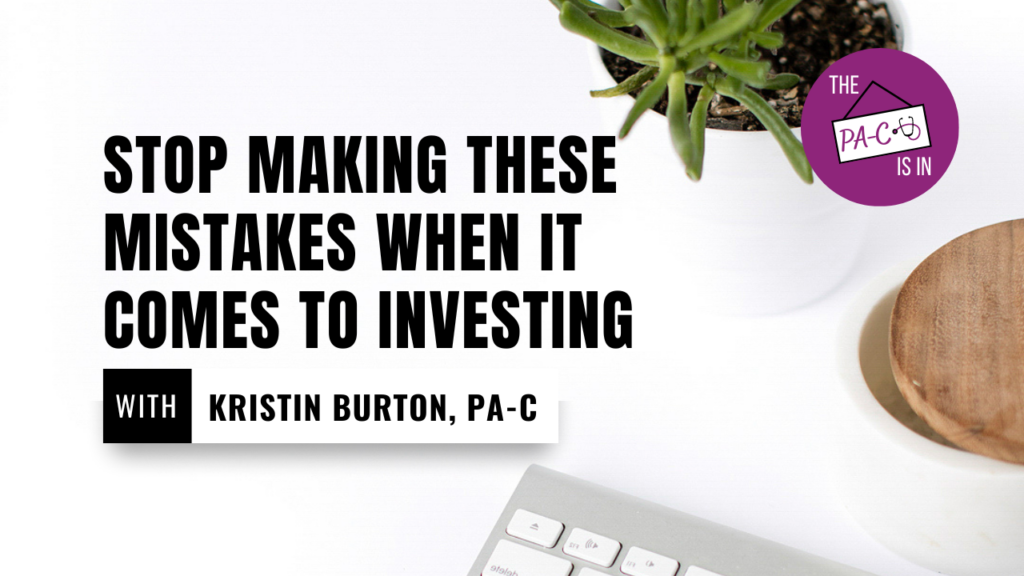
Episode 237: Financial Planning for PAs and NPs: Listen to the podcast | Watch on YouTube | Read the blog
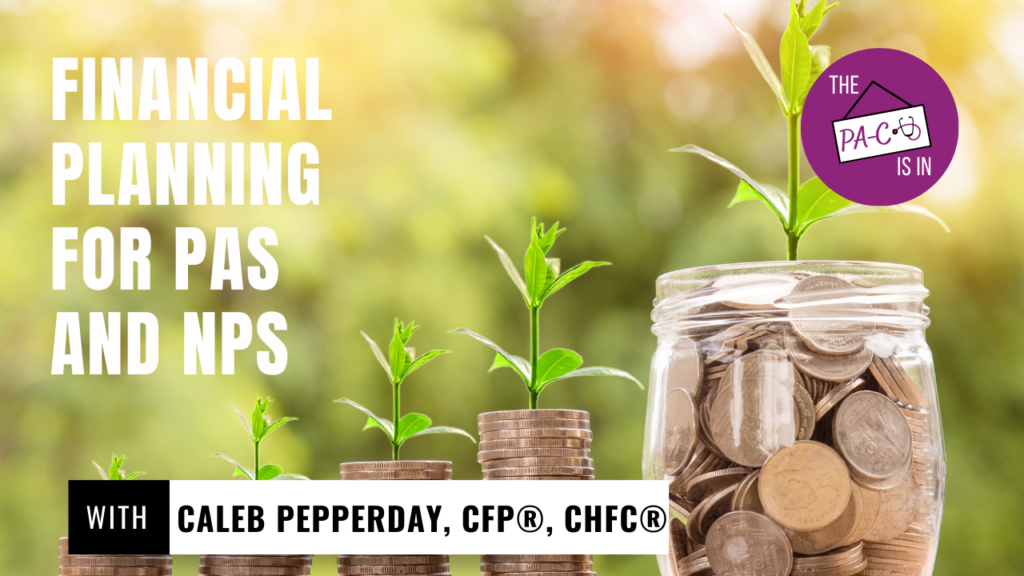
Episode 32: Don’t Pay Off Any Debt…Until You Hear This!: Listen to the podcast

Episode 74: Your Framework for Financial Wellness Listen to the podcast | Read the blog

Episode 139: 5 Keys to Financial Independence: Listen to the podcast | Read the blog

Episode 141: 5 Accounts to Build Wealth: Listen to the podcast | Read the blog

Episode 36: The “Personal” Part of Your Personal Finances: Listen to the podcast | Read the blog
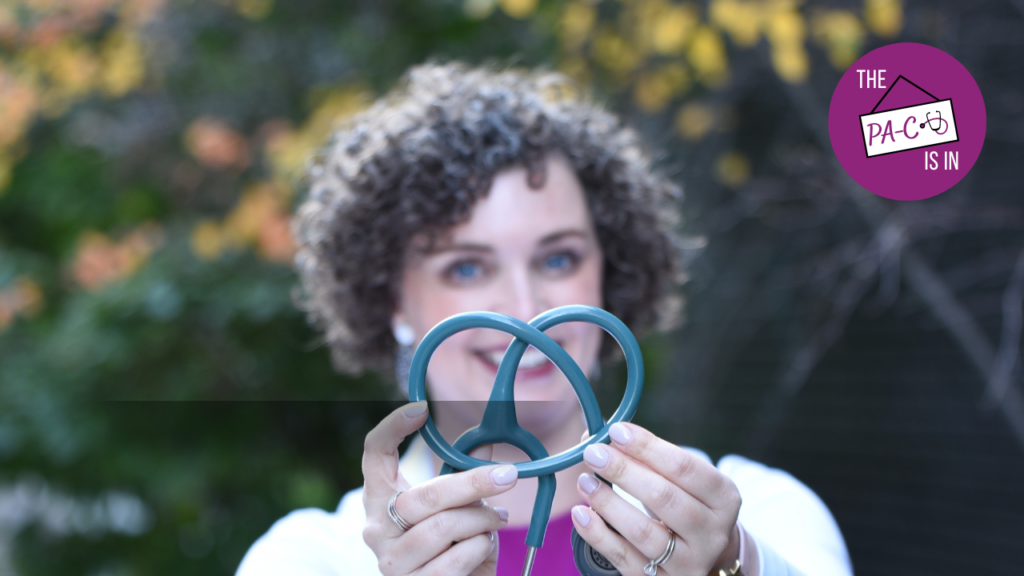
Episode 34: How to Actually Save for Retirement as a Busy Working Mom: Listen to the podcast | Read the blog
